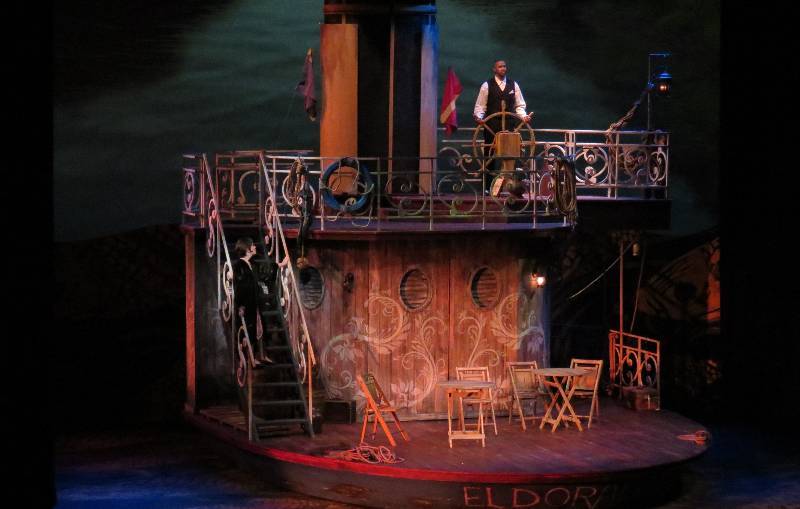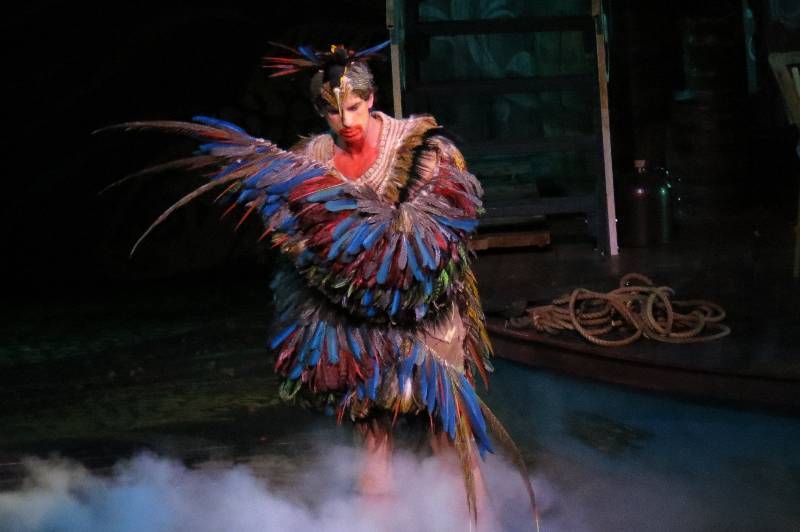 For many audiences, “opera” calls to mind the image of a full-figured woman in a Viking helmet and shield belting out an unintelligible, musically indecipherable aria. Daniel Catán’s opera Florencia en el Amazonas, however, could not stand further apart from this stereotype. Having just received its premiere in 1996, Florencia en el Amazonas, with its relatively contemporary story, film-like music, beautiful visuals, and relatable characters, promises to smash every preconceived notion of opera in the upcoming University of Illinois production at Krannert Center.
For many audiences, “opera” calls to mind the image of a full-figured woman in a Viking helmet and shield belting out an unintelligible, musically indecipherable aria. Daniel Catán’s opera Florencia en el Amazonas, however, could not stand further apart from this stereotype. Having just received its premiere in 1996, Florencia en el Amazonas, with its relatively contemporary story, film-like music, beautiful visuals, and relatable characters, promises to smash every preconceived notion of opera in the upcoming University of Illinois production at Krannert Center.
Set in the early 20th century, the Spanish-language opera Florencia tells a story reminiscent of the magical realism found in a Gabriel Garcia Márquez novel. After making a career as an opera singer, the fictional Florencia Grimaldi is sailing down the Amazon River to her native Latin America, ostensibly to the Manaus opera house, but also to find her long-lost lover Cristóbal, the butterfly hunter. Her companions on the ship include Paula and Alvaro, an unhappily married couple; Rosabla, the journalist working on a biography of Florencia; the Captain of the ship; and his nephew and apprentice Arcadio. Throughout the opera, the characters grapple in their own ways with both love and life, as the situations they face force them to come to terms with each. As cast member Elizabeth Thompson (who plays Rosalba) points out, combining the elements of the realistic and the fantastical leads to a unique kind of balance in the story: “The honesty of its characters strikes home to that of an entirely genuine human experience; however, the fantasy of this story allows us to experience something beyond our present knowledge of reality.
 Christin Colvin performing in the opera’s title role of Florencia.
Christin Colvin performing in the opera’s title role of Florencia.
Musically speaking, Catán’s score bears the influence of both Stravinsky’s pared-down, harmonically adventurous neoclassicism and Puccini’s unabashed romanticism, resulting in a clear but lush blend of orchestra and vocals akin to a modern film score. For a sampling of Catán’s music from this opera, see the following Youtube video to an audio-only recording of Act I, Scene I.
The story and the music, though, do not make up the entirety of the opera-going experience. In fact, a huge part of opera’s appeal comes from its visual elements, namely the set and the costumes. For this particular production, the stage crew faced the challenge of putting on a professional-level production on a comparatively sparse budget. They have, however, met this challenge head on, in part through the use of projected backdrop images, according to artistic director Stephen Fiol:
The technology in this show is kind of remarkable. We couldn’t afford to have drops coming in, but [projections] work just as well to give a sense of time passing as well as motion. The future of opera will have to look at ways to be more cost effective, and one of those ways will be through technology like this.
In front of the projections, the riverboat El Dorado stands as the key set piece upon which almost all of the drama takes place. Reuben Lucas, a freelance stage designer from Chicago hired for this production, spoke a bit about the ship and its design. “We didn’t want a static boat for the opera, so it moves throughout the show; it’s computer-controlled and moves around a pivot point to various orientations,” he explained. Having so much of the drama take place on board this ship, however, presents an interesting staging challenge, as Fiol pointed out:
One of the difficulties of this opera is the limitation of space on the boat. There aren’t a lot of places to go, except during act two which involves the magical glitter beach. There’s also a small cast with few entrances and exits, so we end up really using the two levels of the boats to give the show visual interest.
 Christin Colvin (Florencia) and Jorge Belonni (the Captain) sing from two different levels of the ship, a method that the directors used to add visual interest to the staging.
Christin Colvin (Florencia) and Jorge Belonni (the Captain) sing from two different levels of the ship, a method that the directors used to add visual interest to the staging.
In addition to the set, costumes also presented a challenge for the production crew in terms of budgetary restraints. Fortunately, although Catán had in mind that the story was to take place around 1906, the exact date is somewhat flexible, giving those in charge of costumes some wiggle room to work with costumes already in stock at Krannert Center. “If you can pull things that are already in stock, it saves a considerable amount of money. We had a lot of costume pieces from 1925, so our production takes place in 1925,” Fiol joked.
Costume designers still had opportunity to be creative, though, particularly working with the costume for the character Riolobo, a mystical river being who appears in various guises, both human and non-human. Timothy Renner, who plays Riolobo, said that in creating this costume, they had to take into account how it would affect him vocally:
My costume for the Invocation scene, during the storm, is the most unusual one in the opera, but the designers did a wonderful job creating something that does not hamper my vocal mechanism too much. It is challenging to perform some of the choreography in this scene while maintaining a firmly grounded breath, but making minor adjustments sometimes actually play to my advantage in my technique.
 Timothy Renner performs Riolobo’s Invocation scene, which involves the most elaborate costume in the production.
Timothy Renner performs Riolobo’s Invocation scene, which involves the most elaborate costume in the production.
Beyond the challenges posed in terms of costumes and sets, the cast members, including Thompson and Renner, have faced what some might consider the daunting task of memorizing an opera’s worth of music and getting into character in a matter of about eight weeks. “I think the most challenging part of this production has been the speed at which [the singers] have had to put it together. Two months from scratch to the final product,” Renner said, speaking to the magnitude of this undertaking.
Such a task has involved near daily, hours-long rehearsals, yet during this time, cast members have the chance to explore the inner lives and psyches of their characters in depth. For Renner, this exploration of his character Riolobo has proven one of the most rewarding parts of performing in this opera. “I really enjoy the fact that Riolobo is a special character; he has magical connections with the Amazonas, the spirits of the river. His secret, true nature affects the way he does everyday things, and that has been intriguing for me to explore,” Renner said.
Thompson similarly described the intrigue that her character Rosalba holds for her:
I love playing Rosalba. As a journalist (and a woman journalist during a time in which that was quite unusual), she articulates her experiences and thoughts in a wonderful way. She deals with issues through her character’s emotional journey in ways with which I can very much empathize. I love that she’s a character who is reserved, thoughtful, studious, but then in a flash, out pours a passion and heartfelt soulfulness that might otherwise has been overlooked by passers-by.
After months of set-building, costume-designing, and intense rehearsal, though, perhaps the most exciting part for everyone involved is finally putting on the show for a live audience. When the show opens on Thursday night, it will mark the culmination of everyone’s efforts, and hopes run high for a positive audience response.
“Florencia en el Amazonas is a truly beautiful opera, full of beautiful characters and music. Beyond the initial enjoyment of the musical and visual aspects this production has to offer, I’m also hoping that audience members who may have previously been skeptical of contemporary opera, or even unaware of the existence of an opera in Spanish, will be won over,” Thompson said.
Florencia en el Amazonas will run in Krannert Center’s Tryon Festival Theater from Thursday, November 8 until Sunday, November 11. Shows begin at 7:30 p.m., with the exception of Sunday’s show, which begins at 3:00 p.m. For ticket information, visit Krannert’s website.








